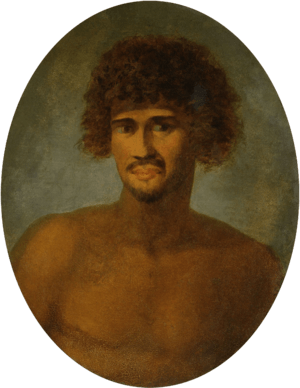Pōmare I facts for kids
Quick facts for kids Pōmare I |
|
|---|---|

Painting of Pōmare I by John Webber
|
|
| King of Tahiti | |
| Reign | 1788 – 13 February 1791 |
| Predecessor | Inaugural |
| Successor | Pōmare II |
| Born | Tu-nui-ea’a-i-te-Atua-i-Tarahoi Vaira’atoa Taina c. 1753 Pare, Tahiti |
| Died | December 3, 1803 Matavai, Tahiti |
| Burial | Pōmare Royal Cemetery, Papaʻoa, ʻArue |
| Spouse | Tu-ra’i-Ari’i Te-ra’i-mano Tetua-nui-rei-a-ite Ra’iatea-i-Nu’urua Pateamai Vairareti Teano Pepiri (junior wife) |
| Issue | Pōmare II Teri’i Tapa-nui Vehiatua V Te Ari’i-na-vaho-roa A son A daughter |
| House | House of Pōmare |
| Father | Teu Tunuieaite Atua |
| Mother | Tetupaia-i-Hauiri |
| Religion | Tahitian |
Pōmare I (born around 1753, died 1803) was a very important leader in Tahiti. He was the first person to unite the different parts of Tahiti into one kingdom. He became the first King of Tahiti in 1788 and founded the Pōmare dynasty. He is also well-known because he was the ruler of Tahiti when the famous mutiny happened on the ship Bounty in 1789. Even after he stepped down as king, he continued to guide his son, Pōmare II, who became the next king.
Contents
What's in a Name?
Pōmare I had a few names. One of his formal names was Tu-nui-e-a'a-i-te-atua. This name means "Great-Tū, road-to-the-god." Tū was a major god in Tahitian beliefs.
The name Pōmare was adopted later. It means "night cougher." He chose this nickname to honor his daughter, Princess Teri’inavahoroa. She sadly passed away in 1792.
The Life of King Pōmare I
Pōmare I, whose birth name was Tu, was born in Pare around 1753. His father was Teu, a chief from Pare-'Arue. His mother was Tetupaia-i-Hauiri.
Tu became the leader of Porionu'u after his father died in 1802. He worked to bring together the different chiefdoms of Tahiti. He successfully united the islands of Tahiti, Moorea, Mehetia, and Tetiaroa. This made him the first king of a unified Tahiti in 1788.
The Bounty Mutiny and Pōmare
One year after becoming king, Pōmare I met the crew of HMS Bounty. The ship had come to Tahiti to collect breadfruit plants. These plants were meant to be taken to the Caribbean.
Later, the crew of the Bounty had a mutiny. Some of the mutineers briefly returned to Tahiti. Pōmare I offered them protection. Eventually, they left Tahiti and settled on Pitcairn. A few mutineers stayed behind. When HMS Pandora arrived, Pōmare I allowed the British to arrest these mutineers. They were then taken back to England for trial.
In 1791, Pōmare I stepped down as king. His son, Tū Tūnuiʻēʻaiteatua Pōmare II, became the new ruler. However, Pōmare I remained an important leader. He acted as a guardian and guide for his young son until 1803. In 1792, HMS Providence visited Tahiti. Pōmare I was reunited with William Bligh, who had been the captain of the Bounty. Bligh asked Pōmare I about the mutineers.
Pōmare I was married four times. He had three sons and three daughters. He passed away in 1803.
Pōmare I in Movies
Because of his role during the Bounty mutiny, Pōmare I has been shown in many films about the event.
In the 1935 film Mutiny on the Bounty, he was called "Chief Hitihiti." He was played by Bill Bambridge. In the 1962 remake, also called Mutiny on the Bounty, he was again "Chief Hitihiti," played by Matahiariʻi Tama.
In the 1984 film The Bounty, he was known as "King Tynah." New Zealand actor Wi Kuki Kaa played him. Some historical records suggest that "Tynah" might have been a different important chief, not Pōmare I himself.
See also
 In Spanish: Pōmare I de Tahití para niños
In Spanish: Pōmare I de Tahití para niños

